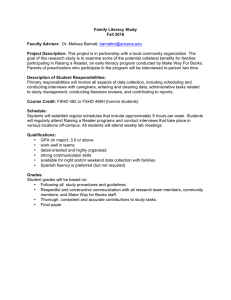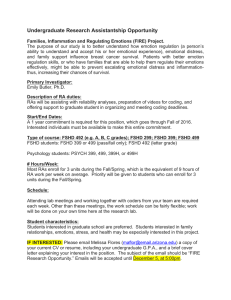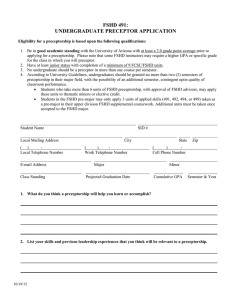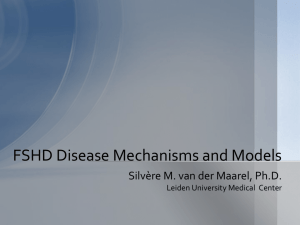Physical Therapy & FSHD A Guide for Patients & Physical Therapists
advertisement
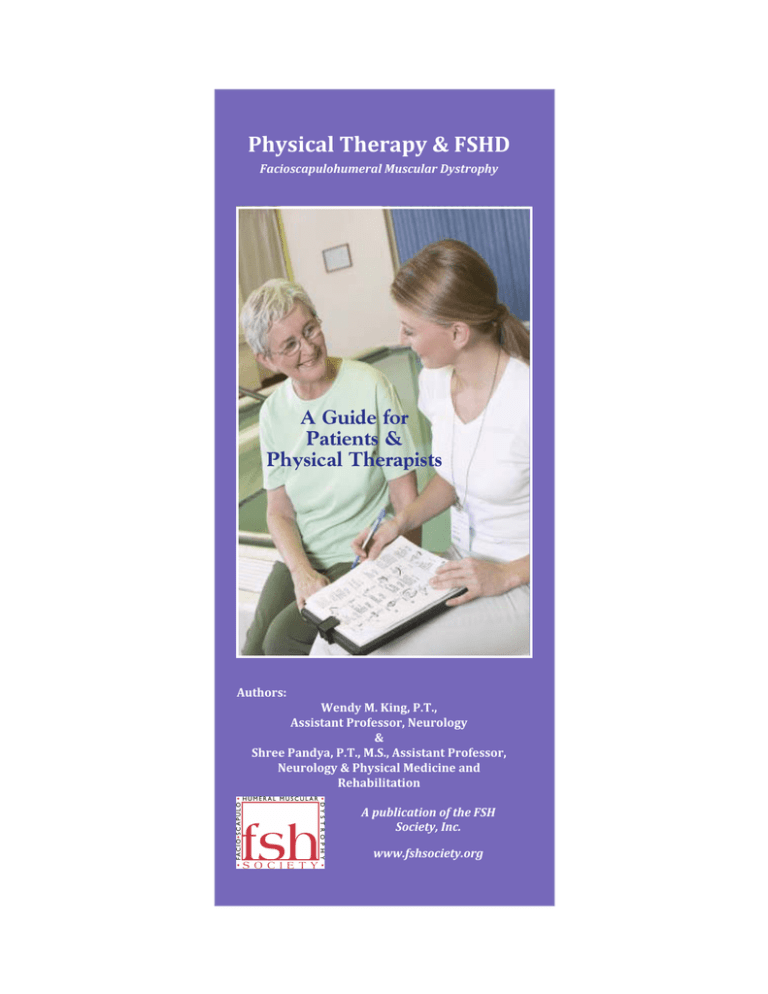
Physical Therapy & FSHD Facioscapulohumeral Muscular Dystrophy A Guide for Patients & Physical Therapists Authors: Wendy M. King, P.T., Assistant Professor, Neurology & Shree Pandya, P.T., M.S., Assistant Professor, Neurology & Physical Medicine and Rehabilitation A publication of the FSH Society, Inc. www.fshsociety.org Table of Contents Introduction ...............................................................................4 Facioscapulohumeral Dystrophy (FSHD) .....................5 Manifestations of Impairments Related to FSHD ......5 Exercise and FSHD ...................................................................7 Hydrotherapy (Water Therapy) and FSHD ..................9 Pain and FSHD ...........................................................................9 Surgical Management of Scapular Problems ............11 Who Are Physical Therapists &What Can You Expect When You See Them? .................................12 To Physical Therapists .......................................................14 Treatment of Pain .................................................................15 Summary ...................................................................................16 References ................................................................................17 About the FSH Society .........................................................18 Contact Information .............................................................19 ‐3‐ Introduction T he purpose of this guide is to assist physical therapists and patients to develop an individualized plan of care based on the best research evidence, clinician expertise and patient preferences. The goals of any physical therapy plan of care are to assist patients to: Maintain optimum health Prevent/Delay secondary complications Maximize functional abilities Improve/Maintain quality of life Based on the patient’s needs, the therapist’s role may be that of a consultant, educator, and/or hands‐on service provider. Depending on the patient’s signs and symptoms and functional limitations, the individualized plan may include recommendations about appropriate activities, exercises, modalities for pain relief, orthotics, adaptive devices and/or home modifications. We have emphasized individual plans of care rather than specific recommendations because FSHD, unlike some of the other muscular dystrophies, is a very heterogeneous condition – patients can present with a specific combination of muscle involvement and progress at a specific rate that is unique to them. There is extreme variability relative to age of onset, degree of weakness and rate of progression. This guide is designed to supplement and complement information available from other lay and professional organizations. We hope that the information provided here will assist therapists and patients to work together to meet individual needs. We look forward to your feedback to help us improve and update our recommendations. We dedicate this guide to Stephen Jacobsen, Ph.D. for his unfailing commitment to the work of the FSH Society and support of this publication. This guide was paid for by the FSH Society under an FSH Society Delta Railroad Construction Grant. Further contributions and comments were provided by the FSH Society, Inc. Scientific Advisory Board, and the FSH Society, Inc. Board of Directors. ‐4‐ Facioscapulohumeral Dystrophy (FSHD) F SHD is an inherited degenerative disorder of muscles with prominent involvement of muscles of the face, shoulder girdle and upper arm early in the disease. It is an autosomal dominant disorder meaning that in virtually all cases an affected individual who carries the genetic abnormality that causes FSHD has a 50‐50 chance of passing the disorder onto each offspring. The vast majority of inherited cases are linked to a genetic lesion on chromosome 4 (4q35). However, the FSHD genomic mechanism arising from that lesion is unknown. Most individuals seek medical attention in the second decade due to increasing difficulties with overhead activities or activities such as climbing stairs and walking on uneven surfaces. A small minority may not notice muscle weakness and, at the other end of the spectrum, a small percentage of individuals are diagnosed in the first decade. Earlier onset is associated with a larger piece of missing DNA and a faster progression of weakness. Manifestations of Impairments Related to FSHD F SHD, as the name implies, initially affects muscles of the face (facio), shoulder blade (scapulo) and upper arm (humeral) muscles. However, in addition to the face, shoulders and upper arms, other skeletal muscles are sometimes affected severely. Specifically, muscles around the hips (pelvic girdle), on the back of the thigh (hamstring group), stomach (abdominal), and on top of the ankle that pull the foot up towards the head (ankle dorsiflexors), can develop significant weakness early in the disease process.1 In an FSHD natural history study (a study that attempts to define the typical characteristics of a disorder and changes over time) the findings showed the weakest muscles were the muscles that connect the shoulder blade to the spine in the upper back (scapular stabilizers), the shoulder muscles that rotate the arm outward (external rotators), the chest muscles (pectorals), the muscles that bend the elbow ‐5‐ (biceps and brachioradialis), the muscles that bend the knee (hamstring group), and the muscles that bend the foot up (ankle dorsiflexors). In this same study, most individuals stated that their first symptoms occurred during their teens, but it was several years before they sought and/or received a diagnosis. The weakness in the majority of patients progresses very slowly and a significant decline in strength could only be documented after twelve months of following a group of 90 patients.2 Generally, FSHD displays a characteristic gradual spread of muscle involvement, starting in the face and slowly progressing to the shoulder and upper‐ arm musculature and to the abdominal and foot‐ extensor muscles. Foot dorsiflexion weakness leading to foot drop is an early manifestation of FSHD and one amenable to the use of molded ankle–foot orthoses (AFO).14 13 The most common initial symptom is difficulty reaching above shoulder level. Foot drop is a less common symptom; such patients, however, almost always have compensated asymptomatic scapular fixator and facial weakness on examination. Truncal weakness is an early and frequent manifestation that is easily overlooked during examination of patients. Weak abdominal muscles result in a protuberant abdomen and contribute to lumbar lordosis. Lower abdominal muscles are weaker than the upper abdominal muscles, causing a strikingly positive Beevor’s sign, a physical finding fairly specific for 14 FSHD. Mild to severe bilateral sensorineural hearing loss and abnormal blood vessels within the eye can be associated with FSHD. Usually these features are asymptomatic (meaning the affected person is not aware of the abnormality), but individuals with these complications should be followed by the appropriate specialists.3 Associated non‐skeletal muscle manifestations include high‐frequency hearing loss as well as retinal telangiectasias, both of which are rarely symptomatic.14 Approximately half of the patients present with subclinical high‐tone hearing loss and retinovasculopathy.13 Hearing loss is often more severe in infantile‐onset FSHD and if not detected ‐6‐ and treated early can interfere with learning and cognitive development. Audiograms should be performed on all patients diagnosed with infantile FSHD.14 Cardiac involvement that causes symptoms is uncommon in FSHD, but individuals should be monitored.3 Likewise, serious respiratory involvement can occur in FSHD, although often late in the disease course.4 Persons with FSHD should ask their physician as to appropriate respiratory monitoring. Symptoms and signs of respiratory insufficiency should be sought during routine clinic visits in patients with moderate to severe FSHD. Regular monitoring of respiratory function is suggested; one might experience insufficiency without presenting signs over a long period of time. Symptomatic respiratory insufficiency can be initially managed with nighttime non‐invasive pressure support (e.g., a BiPAP machine). In very severe cases, patients may require the use of a ventilator. In standard practice, trauma (ER, ICU), surgery and anesthesiology settings, care should be taken not to suppress respiratory drive with narcotics unless it is a situation of palliative care. Oxygen supplementation can be detrimental to patients with hypercarbic (high CO2) respiratory failure. A physician/pulmonologist can help to periodically monitor CO2 levels. Exercise and FSHD A lthough there have been many studies that examined the effect of exercise in neuromuscular disease, these typically combined individuals with various disorders (only a few of which were FSHD) and were short‐term studies (three months or less). Only one study has involved exclusively FSHD subjects and was 12 months in length. Because of these limitations, it is difficult to extrapolate many “conclusions” for the FSHD community. But in general, no negative effects were observed in studies that involved aerobic exercise (exercises designed to temporarily increase heart rate and respiration), and few negative effects have been observed in studies looking at resistive exercise (exercise using any type of weight or resistance). The only 12‐month study concluded that: 5 6 ‐7‐ “On the basis of our experience in this trial we tell our FSHD patients that normal participation in sports and work appears not to harm their muscles… On the other hand, there is insufficient ground for general prescription of exercise programs in FSHD.”5 There are two chief concerns in regard to individuals with FSHD performing resistive exercise. First, individuals with FSHD usually have striking differences in muscle strength among different muscle groups. It is difficult to safely exercise a strong or only mildly weakened muscle without risking overuse or stretch injury to a much weaker muscle that is also involved in performing the exercise.7 The second concern is that depending on the degree of weakness of a person with FSHD, some muscles may be working (exercising) to their maximum just to perform activities of daily living (ADL) against the force of gravity. A weak scapular (shoulder blade) stabilizer muscle such as the serratus anterior or middle trapezius for example, will be challenged to complete daily showering, hair washing, and hair combing tasks. These specific muscles may need to rest and not perform additional resistive exercises. Whether an individual with FSHD should be involved in a resistive exercise program depends on that person’s degree of weakness among various muscle groups and, most importantly, what that person’s normal activity level may be. An individual who has a desk job, does not have young children, and does not have typical housework chores may benefit from a carefully chosen exercise program. But an individual who works full time as a grocery store cashier or a parent who has a nine month old baby to lift and carry may actually be risking damage to shoulder and elbow muscles if he or she adds resistive exercises to their daily routine. However, in the case of Duchenne muscular dystrophy and at least some of the limb girdle muscular dystrophies, resistive exercise can lead to hastened muscle weakness. Because the FSHD genomic mechanism arising from the 4q35 contraction lesion is unknown, no one can say with ‐8‐ certainty what role exercise has in this disorder. Until the specific molecular mechanism is understood, the role of resistive exercise in FSHD will remain uncertain. If an individual with FSHD decides to begin an exercise program, he or she should obtain baseline strength measurements prior to beginning the exercise program. Once baseline muscle strength data has been gathered, then the individual should return periodically for follow‐up evaluations. It is often helpful for the individual to maintain a daily log of his/her ADL, specific exercises performed and the duration, and symptoms experienced on the following day. By documenting physical tasks (both routine and exercise) along with physical well being (including pain and fatigue), an individual with FSHD will be able to establish whether the exercise program is beneficial – at least in the short term. A physical therapist with experience in FSHD is the ideal person to perform the strength evaluation but, at minimum, a health professional familiar with neuromuscular diseases and willing to learn about the unique aspects of FSHD is essential. Aerobic exercise such as bicycling, walking and swimming may be emphasized as this form of exercise is less mechanically stressful on the muscle fibers (and therefore there is less chance of muscle damage) and it improves the overall fitness and stamina of the person. Hydrotherapy (Water Therapy) and FSHD T here have been no controlled trials studying the effects of hydrotherapy and FSHD. Physical therapists encourage hydrotherapy in all types of muscular dystrophy because the buoyancy of the water acts to assist mobility. Also, hydrotherapy can be an efficient means of exercise, as many muscles can be worked at the same time. On a practical basis, however, adults may avoid hydrotherapy because of accessibility, safety issues, or social embarrassment.8 Pain and FSHD A lthough there is a paucity of information in the medical literature,9,10 many individuals with FSHD report that they suffer from chronic pain. There are several proposed reasons for this. First, and probably most commonly, people with FSHD ‐9‐ have muscle strength imbalances between opposing muscle groups. For example, most individuals have significantly weak muscles that attach from the spinal vertebrae to each shoulder blade (the scapular stabilizer muscles). These muscles must contract (and thus shorten) to stabilize or fix each shoulder blade in place. If the shoulder blade is not able to “set” itself prior to the arm being raised or an object being carried, it “wings” out and the individual cannot use the arm effectively for lifting or carrying. These weak muscles will lengthen or “stretch” over time if they are opposed by muscles that are stronger. In this example, the muscles in the front of the chest (the pectoral muscles) may also be weak, but usually are stronger than the shoulder stabilizer muscles and will tend to pull the shoulders forward. Because the pectoral muscles are stronger, they will become tight or shortened. What does this have to do with pain? All muscles have a normal resting length. If some muscles are chronically in a lengthened or shortened position, nerve fibers within the muscle will send out signals that something is not right – a request, if you will, for the individual to fix the problem by changing the muscle position. If the lengthened or stretched muscle cannot be readjusted, chronic pain will occur. Another reason for chronic pain in FSHD is that often muscles are asked to perform tasks that are beyond their capability. Again, these same muscles are struggling to contract (shorten) over and over again and because they are weak they are unable to contract sufficiently. Over time, the muscle tissue and associated connective tissue will become inflamed and painful. It is similar to a person without muscle disease who “over does it” with household chores or a sports activity. The nerve fibers within the “abused” muscles send signals to warn the person that “enough is enough,” and please, could we stop now? If the person does stop the activity and the muscles are allowed to rest, there usually is recovery. A person with FSHD, though, commonly is never able to rest the weakened muscle sufficiently. Because of the previously described muscle imbalances, muscle groups tend to be overused and/or kept in an abnormal resting length. ‐10‐ The most common areas of pain for individuals with FSHD are the upper back and shoulders, the low back, and the hips. These are the same areas where some of the most extreme muscle imbalances occur. Occasionally, severe weakness in the shoulder region causes persistent drooping of the shoulders. If severe enough, this can produce traction on the brachial plexus, a group of nerves in the shoulder/armpit region that supplies the arm. Sometimes this can stretch the nerves severely enough that they can be damaged, producing weakness, numbness, and cramp‐like phenomena.1 If a muscle group is so severely weakened that it cannot overcome the force of gravity, exercise may be contraindicated. Because of the severe weakness, the muscles cannot maintain their normal length. Sometimes wearing an external support can contribute to pain relief by maintaining the weak muscles closer to their normal length. An example of this would be the abdominal muscles. Almost always, the abdominal muscles become weak early in the course of FSHD.1,11 Individuals with FSHD often ask for exercises to strengthen the abdominals. Unfortunately, most often the muscles are too weak for an exercise program, but they may benefit from an abdominal binder. This soft orthosis (brace) can assist in keeping the stomach muscles nearer to their normal length. In addition, such a support will help protect the low back muscles, which are strained and at risk of injury when the abdominal muscles are weak. Surgical Management of Scapular Problems W eakness of the scapular stabilizers can lead to significant winging, loss of ability to perform overhead activities and, in some cases, problems due to pain. Over the years various surgical and non‐ surgical methods have been developed to provide stability at the shoulder and to improve and/or maintain ability to perform overhead activities. Non‐surgical options using braces (scapular retraction orthosis) have provided limited benefit because the pressure needed to keep the scapula fixed is not tolerable for extended periods of time. It may be an option for specific activities or limited time periods only. ‐11‐ Surgical procedures involve fixing the scapula to the thorax with the help of fascial or synthetic slings (scapuloplexy) or by fastening it with wires, screws or plates (scapulodesis). Bone grafts from the pelvic bone may also be used to improve fusion and reduce the period of immobilization post operatively. A recent review of the papers describing the results of these procedures found significant benefit but cautioned that these benefits have to be balanced against the need for post operative immobilization, rehabilitation and complications such as stretching of the slings, loosening of the wires and screws and, in some cases, nerve damage. Bilateral fixing of the scapular can also lead to reduced range of motion of the clavicular joints. Each person needs to be evaluated thoroughly prior to making a decision and needs to weigh the benefits and possible complications carefully before making a decision. Who Are Physical Therapists & What Can You Expect When You See Them? P hysical therapists are health care professionals educated at the college/university level (B.S., M.P.T., D.P.T.). In addition to their professional degrees, they may be certified within certain clinical specialties (N.C.S., O.C.S., etc.) and hold other doctoral degrees (Ph.D., Sc.D., Ed.D.). They are required to be licensed to practice in each state (P.T., R.P.T.). They practice in a variety of inpatient, outpatient and community settings such as clinics, hospitals, home care and in the school systems, to name a few. During your initial visit, the therapist will: obtain a history to understand the development and progression of the problems for which you are being seen; inquire about the tests and results that may have already been obtained; ask about any involvement of the pulmonary and cardiac systems secondary to the muscular dystrophy; want to know about any other past or current medical conditions that may have an impact on your current problems; note any previous or current medical or surgical treatments you have had related to the muscular dystrophy or any other ‐12‐ concomitant conditions; and perform a detailed examination to document the muscle involvement, joint involvement, functional abilities and limitations, and any problems related to pain. After the history and physical examination, the therapist may have a further discussion with you regarding your current activity status based on your family role, occupational needs or recreational interests. The therapist will inquire about your specific goals and will develop a plan to meet your exercise and activity needs that is compatible with your life style and takes into account your daily routines. The therapist will demonstrate and teach any specific exercises that may be appropriate, give you a prescription with specifics about frequency and progression of exercises and activities, and discuss the symptoms that may require you to modify the program and/or seek reexamination. The number and frequency of visits necessary will be determined by the complexity of the program, your comfort with your own role and responsibilities related to the program, and the therapist’s need to monitor the program. Based on the examination and discussions, the therapist may also recommend orthotics/braces and/or other assistive devices, and/or home and workplace modifications to allow you to function at your highest capabilities with the least expenditure of energy. In some cases a wheelchair, electric wheelchair or electric scooter with elevating seat may be indicated as well as adaptive driving controls and ramps. The therapist may also recommend annual evaluations to monitor your condition and make appropriate recommendations. We hope that this brief explanation will allow you to prepare for and make the most of your consultation with a physical therapist. Remember that FSHD is a rare condition and unless the therapist is routinely involved in seeing patients with muscular dystrophies, the therapist may not be familiar with your condition and will appreciate any information you can share with them related to FSHD. So please share this booklet with your therapist. ‐13‐ To Physical Therapists P roviding physical therapy for the patient with FSHD introduces special challenges for the therapist. More than other muscular dystrophies, FSHD can be quite asymmetrical. For example, it is not unusual to grade a muscle on the left as a 4 or above by MMT and the corresponding muscle on the right as a 1 or 2 grade. In another muscle group, however, strength may be stronger on the opposite side. There often appears to be no rhyme or reason to the specific muscle group strengths. There are usually some predictive patterns, however: The upper and lower abdominals are among the first muscle groups to show clinical weakness and rarely are graded above a 3‐. The middle and lower trapezius and serratus anterior muscles also weaken early and are rarely above a 3 grade. The middle deltoid, however, usually is only mildly weakened. Shoulder external rotators are weaker than shoulder internal rotators. Biceps brachii is usually preferentially involved. Knee flexors are weaker than knee extensors. Ankle dorsiflexors are weaker than ankle plantar flexors. Despite, on occasion, radical strength imbalances between a muscle antagonist and agonist, significant joint contractures are rare. Because this autosomal dominant disease is slowly progressive, and perhaps because other members of the family may also have had symptoms for many years, patients sometimes are not referred to a physical therapist until they have endured decades of chronic pain, weakness, and disability. The therapist seeing a patient with FSHD for the first time must begin by gathering information regarding the person’s occupation, leisure activities and role as a parent or caregiver to another person. This should involve detailed questioning of his/her job description, hours at work, responsibilities of keeping a house or apartment, childcare, pets and any other regular physical tasks. It is necessary for the therapist to have a clear sense of the percent of time each day ‐14‐ the person with FSHD spends sitting at a computer, standing, walking, climbing stairs, getting into and out of a vehicle, doing laundry, preparing meals, walking a dog, carrying a toddler, etc. A detailed strength evaluation should then follow. Typically, as this is completed, the therapist has become aware of significant muscle imbalances. Very weak muscles are often over stretched. Stronger muscles may be tight, but again, are probably not producing significant contractures. The person with FSHD inevitably is suffering from chronic pain. The areas most often affected are the cervical area, the upper back, the lower back, and the posterior knee. The areas of pain will correspond with the weakest (and thus over stretched) muscles. Treatment of Pain A sk the patient to keep an activity log for at least several weeks. This can be as detailed as the patient needs it to be, but at minimum, it should have columns for the type of activity, the time of day (15 minutes to blocks of several hours), and symptoms noticed. If the person is accurate and thorough, such a log may well provide very useful information concerning the correspondence of some specific activities and symptoms of fatigue or pain. Treatment of the pain should include instruction for any appropriate stretching or strengthening exercises, evaluation for possible bracing (especially to assist in ankle dorsiflexion, scapular retraction, or to provide abdominal support), and modalities such as moist heat, cold, TENS, massage, etc. Medication may also be required. The use of light weight off the shelf or custom made ankle‐foot orthosis (AFO) works well to correct foot‐drop. The new stance control knee‐ankle‐foot orthosis (KAFO) may benefit a minority of FSHD adults who have significant quadriceps weakness (especially unilaterally) or those who present with knee pain due to chronic genu recurvatum caused by an imbalance between weaker knee flexors than extensors. The type of stance control orthosis that has double uprights at the ankle usually benefits an individual with FSHD in terms of increased stability and decreased fatigue. ‐15‐ Most importantly, the therapist must teach the individual with FSHD strategies to avoid the cycle of chronic musculoskeletal pain. This includes education of any postural deficiencies and ways to minimize them, an honest appraisal of the individual’s lifestyle – both leisure and work, and suggestions for alterations that might result in less emphasis on the weakest muscles. Suggestions could be as simple as trying certain adaptive equipment for bathing, dressing, or housecleaning at home, or a more supportive or height‐appropriate desk chair, or ergonomically correct keyboard and mouse for a laptop or computer station at work. Even if the individual chooses not to use a recommended orthotic device or adaptive equipment, he or she needs to understand the principle behind the recommendation. Summary I n a self‐reported quality‐of‐life questionnaire for individuals with various neuromuscular diseases, the three most frequently cited concerns were muscle weakness, difficulty exercising and fatigue. Other common issues were problems with mobility, pain and weight.12 FSHD is a muscle disease that causes progressive weakness and associated pain along with some degree of disability. Until the cause of FSHD is discovered, individuals with FSHD should insist that medical professionals, including physical therapists, work aggressively with the FSHD community to minimize the physical and emotional toll caused by this elusive muscle disorder. ‐16‐ References 1. Kissel JT. Facioscapulohumeral dystrophy. Seminars in Neurology 1999;19:35‐43. 2. The FSH‐DY Group. A prospective, quantitative study of the natural history of facioscapulohumeral muscular dystrophy (FSHD): implication for therapeutic trials. Neurology 1997;48:38‐46. 3. Tawil R, Griggs RC. ed, Butterworth‐Heinemann. Facioscapulohumeral dystrophy in the molecular and genetic basis of neurological disease. Rosenberg RN, ed.Butterworth‐Heinemann Publishers 1997 pg 931‐938. 4. Wohlgemuth M, van der Kooi EL, van Kesteren RG, van der Maarel SM, Padberg GW. Ventilatory support in facioscapulohumeral muscular dystrophy. Neurology 2004;63:176‐178. 5. van der Kooi EL, Vogels OJM, van Asseldonk RJGP, Lindeman E, Hendriks JCM, Wohlgemuth M, van der Maarel SM, Padberg GW. Strength training and albuterol in facioscapulohumeral muscular dystrophy. Neurology 2004;63:702‐708. 6. Olsen DB, Orngreen MC, Vissing J. Aerobic training improves exercise performance in facioscapulohumeral muscular dystrophy. Neurology 2005;64:1064‐1066. 7. Kendall, FP, McCreary EK, Provance PG. Muscles: testing and function. 4th ed. Baltimore, Williams & Wilkins, 1993. 8. Eagle, M. Report on the muscular dystrophy campaign workshop: exercise in neuromuscular diseases. Neuromusc Dis 2002;12:975‐983. 9. Bushby KMD, Pollitt C, Rogers MT, Chinnery PF. Muscle pain as a prominent feature of facioscapulohumeral muscular dystrophy (FSHD): four illustrative case reports. Neuromuscular Disorders 1998;8:574‐579. 10. Abresch RT, Carter GT, Jensen MP, Kilmer DD. Assessment of pain and health related quality of life in slowly progressive neuromuscular disease. Am J Hosp Palliat Care 2002;19:39‐48. 11. Awerbuch GI, Nigro MA. Beevor’s sign in facioscapulohumeral muscular dystrophy. Arch. Neurol 1990;47:1208‐1209. 12. Fowler WM. Consensus conference summary: role of physical activity and exercise training in neuromuscular diseases. Am J Phys Med Rehabil 2002;81 (Suppl):S187‐ S195. 13. van der Maarel SM, Frants RR. The D4Z4 repeat‐ mediated pathogenesis of facioscapulohumeral muscular dystrophy. Am J Hum Genet. 2005 Mar; 76(3):375‐86. Review. PMID: 15674778. 14. Tawil R, van der Maarel SM. Facioscapulohumeral muscular dystrophy. Muscle Nerve. 2006 Jul; 34(1):1‐15. Review. PMID: 16508966. ‐17‐ About the FSH Society T he FSH Society is a 501(c)(3) nonprofit, tax‐ exempt U.S. corporation established in 1991 by Daniel P. Perez. The Society solely addresses specific issues and needs regarding facioscapulohumeral muscular dystrophy (FSHD). It actively promotes research toward the prevention, cause and treatment of FSHD. It also helps facilitate support groups where individuals with like concerns have an opportunity to interact and receive helpful information concerning day‐to‐day life with FSHD. The Society publishes a newsletter with information about advances in research, political action effecting FSHD research and profiles of people living successful lives. The newsletter is one of several benefits of membership in the Society. Other services provided by the Society include additional written information about infantile FSHD; genetic and prenatal testing; physical, occupational, speech and hearing therapy; and dietary concerns. The Society also offers assistance and materials to physicians and other professionals interested in FSHD. Anyone with questions about FSHD should contact his or her physician(s), the FSH Society or their local muscular dystrophy association office. The FSH Society depends on your contributions to continue its work in funding research, advocating for research money and educating physicians and the public about FSHD. Please consider helping the FSH Society further with employer matching funds, by including the Society as a beneficiary in estate planning, and by contributing through the United Way and the Combined Federal Campaign. All contributions, memberships and donations will be acknowledged for tax purposes. ‐18‐ Contact Information FSH Society, Inc. 64 Grove Street Watertown, MA 02472 (617) 658‐7878; (617) 658–7877 (617) 658‐7879 fax www.fshsociety.org Daniel Paul Perez President & CEO (781) 275‐7781 daniel.perez@fshsociety.org Nancy Van Zant Executive Director (617) 658‐7878 nancy.vanzant@fshsociety.org Copyright© FSH Society, Inc. 2007 May not be reprinted or copied without permission. Version: May 2009 ‐19‐ FSH Society, Inc. 64 Grove Street Watertown, MA 02472 (617) 658‐7878; (617) 658–7877 (617) 658‐7879 fax www.fshsociety.org
